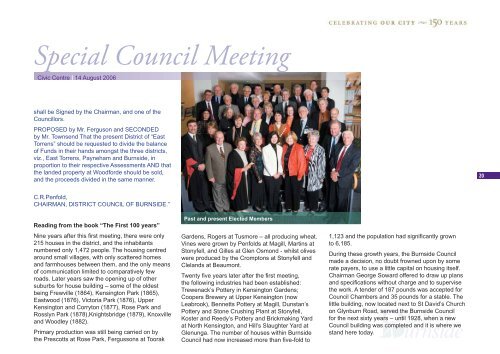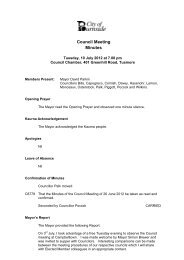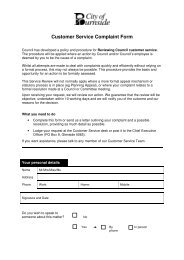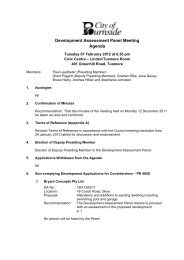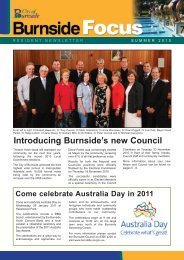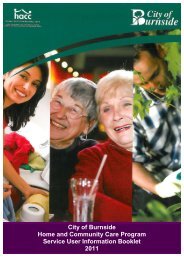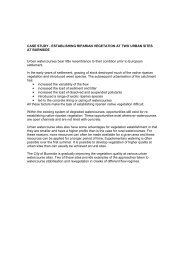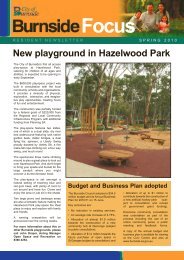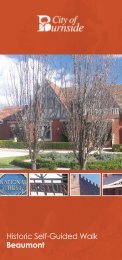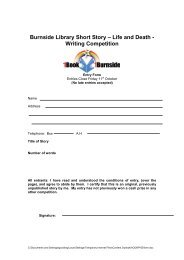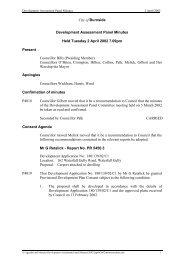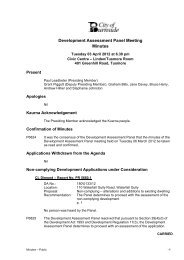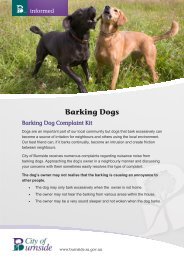Special Council Meeting - City of Burnside
Special Council Meeting - City of Burnside
Special Council Meeting - City of Burnside
You also want an ePaper? Increase the reach of your titles
YUMPU automatically turns print PDFs into web optimized ePapers that Google loves.
<strong>Special</strong> <strong>Council</strong> <strong>Meeting</strong><br />
Civic Centre | 14 August 2006<br />
shall be Signed by the Chairman, and one <strong>of</strong> the<br />
<strong>Council</strong>lors.<br />
PROPOSED by Mr. Ferguson and SECONDED<br />
by Mr. Townsend That the present District <strong>of</strong> “East<br />
Torrens” should be requested to divide the balance<br />
<strong>of</strong> Funds in their hands amongst the three districts,<br />
viz., East Torrens, Payneham and <strong>Burnside</strong>, in<br />
proportion to their respective Assessments AND that<br />
the landed property at Woodforde should be sold,<br />
and the proceeds divided in the same manner.<br />
20<br />
C.R.Penfold,<br />
CHAIRMAN, DISTRICT COUNCIL OF BURNSIDE.”<br />
Reading from the book “The First 100 years”<br />
Nine years after this fi rst meeting, there were only<br />
215 houses in the district, and the inhabitants<br />
numbered only 1,472 people. The housing centred<br />
around small villages, with only scattered homes<br />
and farmhouses between them, and the only means<br />
<strong>of</strong> communication limited to comparatively few<br />
roads. Later years saw the opening up <strong>of</strong> other<br />
suburbs for house building – some <strong>of</strong> the oldest<br />
being Frewville (1864), Kensington Park (1865),<br />
Eastwood (1876), Victoria Park (1876), Upper<br />
Kensington and Corryton (1877), Rose Park and<br />
Rosslyn Park (1878),Knightsbridge (1879), Knoxville<br />
and Woodley (1882).<br />
Primary production was still being carried on by<br />
the Prescotts at Rose Park, Fergussons at Toorak<br />
Past and present Elected Members<br />
Gardens, Rogers at Tusmore – all producing wheat.<br />
Vines were grown by Penfolds at Magill, Martins at<br />
Stonyfell, and Gilles at Glen Osmond - whilst olives<br />
were produced by the Cromptons at Stonyfell and<br />
Clelands at Beaumont.<br />
Twenty fi ve years later after the fi rst meeting,<br />
the following industries had been established:<br />
Trewenack’s Pottery in Kensington Gardens;<br />
Coopers Brewery at Upper Kensington (now<br />
Leabrook), Bennetts Pottery at Magill, Dunstan’s<br />
Pottery and Stone Crushing Plant at Stonyfell,<br />
Koster and Reedy’s Pottery and Brickmaking Yard<br />
at North Kensington, and Hill’s Slaughter Yard at<br />
Glenunga. The number <strong>of</strong> houses within <strong>Burnside</strong><br />
<strong>Council</strong> had now increased more than fi ve-fold to<br />
1,123 and the population had signifi cantly grown<br />
to 6,185.<br />
During these growth years, the <strong>Burnside</strong> <strong>Council</strong><br />
made a decision, no doubt frowned upon by some<br />
rate payers, to use a little capital on housing itself.<br />
Chairman George Soward <strong>of</strong>fered to draw up plans<br />
and specifi cations without charge and to supervise<br />
the work. A tender <strong>of</strong> 187 pounds was accepted for<br />
<strong>Council</strong> Chambers and 35 pounds for a stable. The<br />
little building, now located next to St David’s Church<br />
on Glynburn Road, served the <strong>Burnside</strong> <strong>Council</strong><br />
for the next sixty years – until 1928, when a new<br />
<strong>Council</strong> building was completed and it is where we<br />
stand here today.


